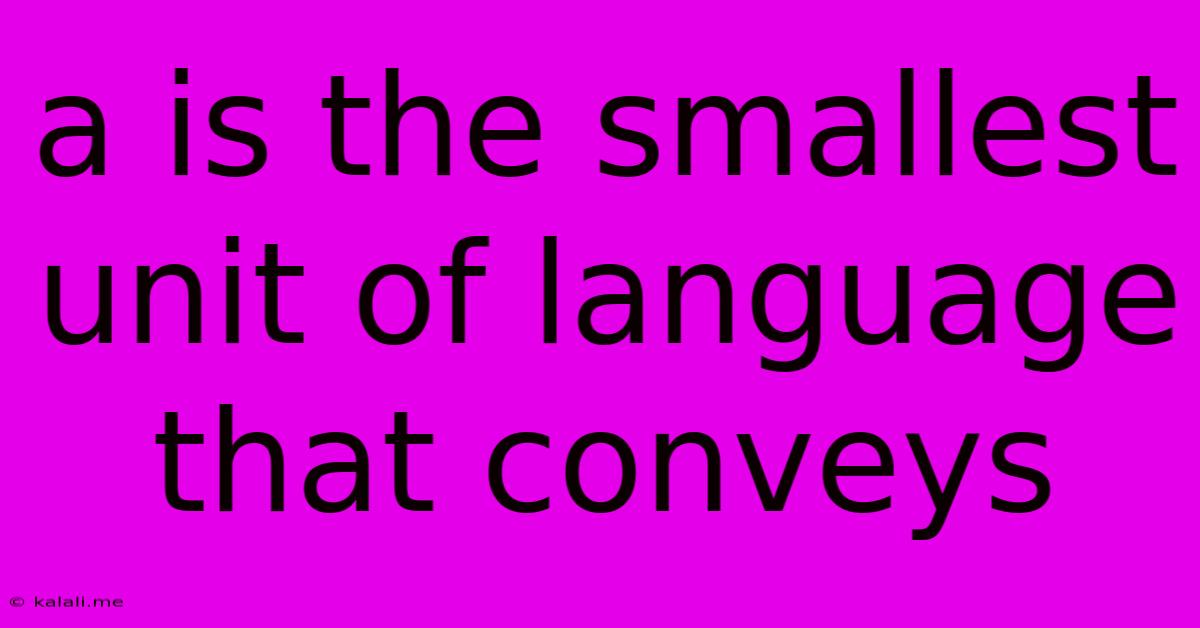A Is The Smallest Unit Of Language That Conveys
Kalali
Jun 14, 2025 · 3 min read

Table of Contents
A is the Smallest Unit of Language that Conveys Meaning: Understanding Morphemes
What's the smallest piece of language that can actually mean something? It's not a letter, and it's not a syllable. The answer is a morpheme. This article will delve into the fascinating world of morphemes, exploring their definition, types, and significance in understanding language structure and meaning. Understanding morphemes is crucial for anyone interested in linguistics, language acquisition, or even just improving their writing and communication skills.
A morpheme is the smallest unit of meaning in a language. Think of it as the fundamental building block of words. It can be a word itself, or a part of a word that carries meaning on its own. Unlike words, which can be broken down into smaller meaningful units, morphemes cannot be further divided without losing their meaning. This seemingly simple concept opens up a complex and enriching exploration of language.
Types of Morphemes: Unlocking the Building Blocks of Words
Morphemes are broadly categorized into two main types:
-
Free Morphemes: These are morphemes that can stand alone as independent words. They carry meaning on their own and don't require other morphemes to be understood. Examples include words like "cat," "dog," "run," "happy," and "beautiful". These are the words we readily identify and use in everyday conversation.
-
Bound Morphemes: Unlike free morphemes, these cannot stand alone. They must be attached to another morpheme (usually a free morpheme) to create a meaningful unit. Bound morphemes often modify the meaning or grammatical function of the word they attach to. There are two main subcategories:
-
Prefixes: These are bound morphemes that are attached to the beginning of a word. Examples include "un-" (unhappy), "pre-" (preheat), and "re-" (rewrite). They often change the meaning of the root word.
-
Suffixes: These are bound morphemes added to the end of a word. Examples include "-ing" (running), "-ed" (walked), "-ly" (quickly), and "-ness" (happiness). They frequently alter the grammatical function of the word (e.g., tense, number, or part of speech). They can also modify the meaning.
-
Infixes: Less common than prefixes and suffixes, infixes are inserted within the root word. They are found in some languages, but not as prevalent in English.
-
Understanding Morphemes in Context: Analyzing Word Structure
Let's take the word "unbreakable". We can break it down into its constituent morphemes:
- un-: A prefix meaning "not" or "opposite of".
- break: A free morpheme meaning "to separate into pieces".
- -able: A suffix meaning "capable of being".
Therefore, "unbreakable" means "not capable of being broken". By understanding the individual morphemes and their contributions to the overall meaning, we gain a deeper appreciation for the word's structure and semantics.
The Importance of Morphemes in Language Acquisition and Processing
Understanding morphemes is vital in several areas:
-
Language Acquisition: Children learning language gradually acquire morphemes, building their vocabulary and grammatical understanding. Mastering morphemes is fundamental to fluent speech and writing.
-
Language Processing: Our brains efficiently process language by recognizing and combining morphemes. This allows for rapid comprehension and communication.
-
Computational Linguistics: In the field of natural language processing (NLP), analyzing morphemes is crucial for tasks like machine translation and text analysis.
In conclusion, morphemes are the essential building blocks of language, conveying the smallest units of meaning. By understanding their different types and functions, we unlock a deeper appreciation of how words are constructed, how language operates, and how humans communicate. The study of morphemes provides invaluable insight into the intricate and fascinating system of human language.
Latest Posts
Latest Posts
-
Difference Between Mixture And Solution Examples
Jun 15, 2025
-
What Is The Antonym Of Inferior
Jun 15, 2025
-
When An Electron Is Removed The Atom Gets A
Jun 15, 2025
-
Moment Of Inertia Of A Thin Ring
Jun 15, 2025
-
How Are Plants Different From Algae
Jun 15, 2025
Related Post
Thank you for visiting our website which covers about A Is The Smallest Unit Of Language That Conveys . We hope the information provided has been useful to you. Feel free to contact us if you have any questions or need further assistance. See you next time and don't miss to bookmark.